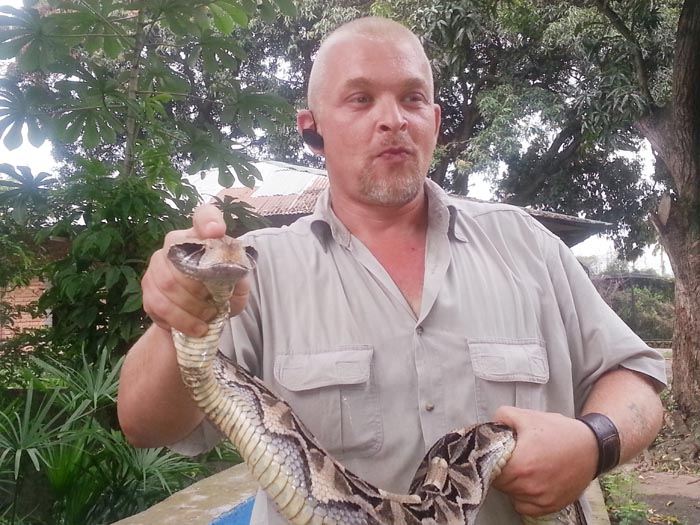Solidarity and Development (SODEVE), is an active association based in Burundi since 15 years now. SODEVE is engaged in the creation of a snake house and a laboratory to make anti-venom serums that will be distributed to treat venomous snakes’ bites.-Joanna Nganda
“What would you do if you were bitten by a venomous snake?” Gianfranco Dematteo asked me during our interview.Then I tried to remember the biology courses we had in school, and answered that I would apply a tourniquet on the bitten limb and use the famous black stone to ‘suck out’ the venom. Brice Rozynski who was sitting near us, specialist in capture, manipulation and extraction of venom from venomous species, explained. “The black stone doesn’t work, and here’s why: the only reason why the stone sticks to the bitten area is due to the presence of coagulating blood, which is sticky. Once the blood dries, the stone will eventually fall off, which is the commonly trusted sign that the venom has been ‘absorbed’ by the stone and no longer in your body. If the victim is lucky enough to have been bitten by a non-venomous snake, then the person will live and give all praises to the traditional practitioner…but in fact, the victim has just got extremely lucky. And by all means, do not let anyone suck the venom from the affected area; you would now have the venom in two people instead of one.”
Gianfranco Dematteo and Brice Rozynski are both from SODEVE. Among their large-scale projects (the rehabilitation and restructuration of the zoo “Musée Vivant”, and the elaboration of an encyclopedia): a snake house to extract venom from snakes, and a laboratory which will use the venom to produce anti-venom serums. Their project, supported by the Ministry of Health, Red Cross and World Health Organization (WHO), will begin during the course of this year. It will be based in Gitega, the center of the country, in order to provide fast actions throughout the country, “when it comes to snake bites, every second counts. The faster we act, the greater the chances of survival,” says Brice Rozynski. Christophe Banzubaze, Curator of ‘Musée Vivant’, expresses his excitement “The project will consolidate tourism safety, and be a huge boost to Burundian tourism. The fact that we have so many venomous snakes and nothing to cure an eventual attack is unbelievable.”“Did you know that in Burundi, there’s no anti-venom serum available?” asks Gianfranco Dematteo. “All what the hospital staff can do is to try and alleviate the pain, but other than that, you are left to a painful and certain death… or an amputation if you are lucky,” he indicates. Indeed, according to the Research and Development Institute (IRD), one million people are bitten by venomous snakes every year, in Africa. 20,000 of the victims succumb to the venom. In 75% of the cases, if the victim survives, the bitten limb is amputated or loses its mobility.
A project Burundi needs
Although Burundi has no database to evaluate snakes’ attacks, IRD statistics are alarming. Plus, among 21 species of snakes in Burundi, 13 are venomous. All this justifies SODEVE initiative. “Cities are expending from the urban area to invade territories that were, up to now, the snake’s natural habitat. And what do cities do? They produce trash, these get infested by rats…the snakes’ meal of choice,” states Gianfranco Dematteo, in charge of the project. Brice Rozynski, Technical Coordinator of the project, explains that extracting snakes’ venom is not an easy task and people will have to be trained; therefore, job opportunities will be created. The other noticeable aspect of the project will be providing free anti-venom treatments to the needy. “In Ivory Coast, a single dose of anti-venom costs roughly BiF 80,000. And in order to fully recover, some patients will spend several months in hospital and will need up to 20 doses of anti-venom! Not anyone can afford it. That’s why we want to make the snake house and laboratory financially self-sustainable, to make the serum affordable and offer free treatment to people who can’t afford it,” says Brice Rozynski, while noting that Burundi will be the 3rd country in the world to have a snake house and anti-venom laboratory, after Thailand and Sao Paulo in Brazil. To have financial autonomy, the project will sell snakes’ venom to international pharmaceutical companies. Indeed, snakes’ venom is receiving a growing interest due to its many positive uses, in the medical and cosmetology fields. By the end of the 3 hour-long interview, I have touched 3 different species of the most deadly snakes and gathered an impressive amount of information; for details consult Iwacu’s website. (www.iwacu-burundi.org).




















 IWACU Open Data
IWACU Open Data

